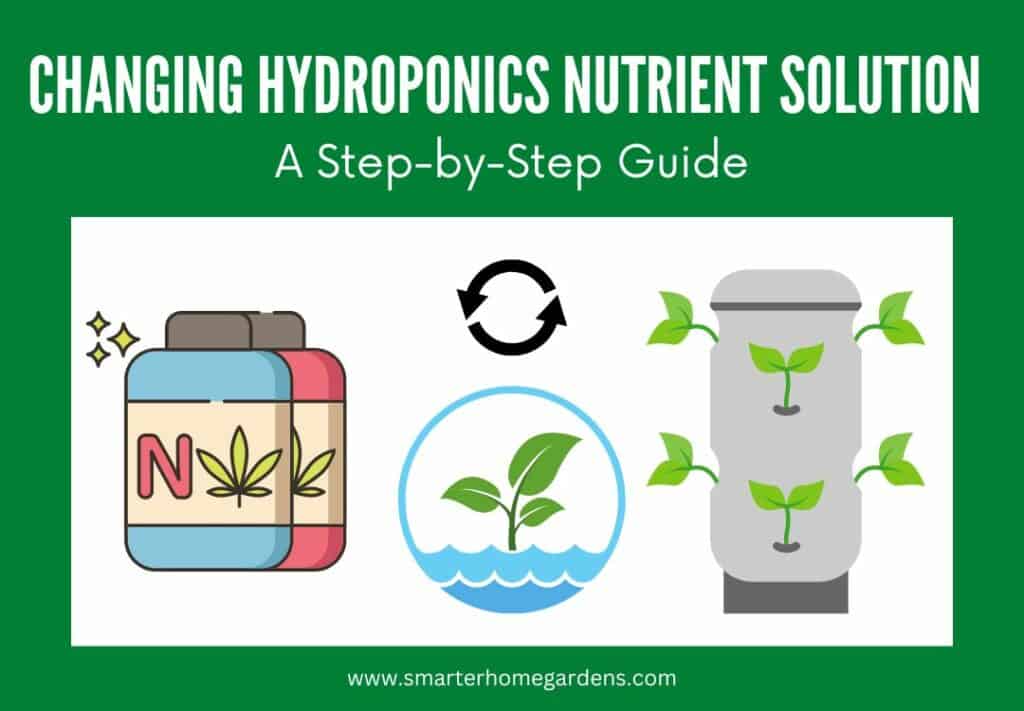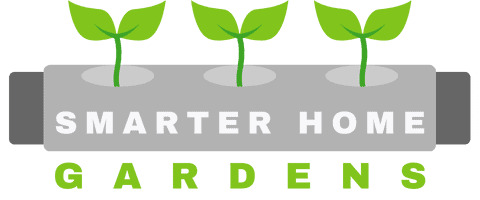This article contains affiliate links. As an Amazon Associate, SmarterHomeGardens.com earns a small commission on qualifying purchases at no extra cost to you.

Hydroponics is an increasingly popular way of growing plants at home. One of the key benefits is that growing plants hydroponically doesn’t require soil. You can grow plants in almost any location, including kitchens, basements, balconies, or gardens. Since your plants won’t be getting their nutrients from the soil, growers need to provide this through a regular flow of nutrient-rich solutions in hydroponics.
Changing the nutrient solution in your hydroponics system is quick and easy. First, drain the old solution from the reservoir and clean it thoroughly, before adding the newly mixed nutrient solution back into the reservoir. As a general rule, changing the solution every 2-4 weeks is usually sufficient, depending on how hungry your plants are.
The exact details of this process may differ slightly, depending on the type of hydroponics system you have. However, in this step-by-step guide, I’ll show you the key actions needed to change the nutrient solution in your hydroponics system, as well as the equipment you can use to make it a quick and efficient process. Let’s get stuck in.
A step-by-step guide to changing the nutrient solutions in hydroponics
Before we start, you may be interested to watch this helpful video from the Family Plot, which simply demonstrates each of the steps I’ve detailed below.
Why do you need to change the nutrient solution?
Most of the plants you grow hydroponically will need large concentrations of the three main nutrients (nitrogen, potassium, and phosphorous) in order to thrive. Changing the nutrient solution in your hydroponics reservoir may seem like a chore, but it’s a super important part of hydroponics maintenance that makes a big difference to your plants.
Keeping nutrients topped up regularly provides the food that your plants need in order to grow and thrive. Without a regular flow of nutrients, your plants will not get what they need to grow big and strong or produce fruits and vegetables worthy of harvesting.
How often do you need to change the nutrient solution – really?
As a general rule, the nutrient solution should be changed every 2-4 weeks, depending on how thirsty and hungry the plants that you are trying to grow are.
Step 1: Get prepared
Before you can drain and replace your old nutrient solution you’ll need to make sure you have all the necessary supplies and tools to get the job done. This will help to ensure a smooth and efficient process while minimizing any risks.
What supplies will you need?
I’ve put together a handy list in the table below. Make sure you have all of these items to hand before proceeding with changing your nutrient solution.
| Shopping List | Description | Amazon.com Link |
|---|---|---|
| Hydroponics Specific Nutrients | Nutrients are the lifeblood of any hydroponics system. Before draining your old solution away, make sure you have a fresh batch of nutrients handy. And, make sure they are nutrients designed specifically to support hydroponics growth. I personally like the ‘Flora’ series from General Hydroponics. | My recommended product |
| A pH Meter | A pH Meter is a device that measures the acidity or alkalinity of your nutrient solution. The pH level of your nutrient solution is critical as it regulates the availability of nutrients to the plant’s roots. Make sure you have one and use it to keep the pH of your new solution between 5.5 and 6.5. | My recommended product |
| EC/TDS Meter | EC (Electrical Conductivity) is a measure of how well an electric current can flow through a solution. It can be used to measure the concentration of nutrients in your nutrient solution. TDS (Total Dissolved Solids) similarly measures the concentration of your nutrient solution with outputs measured in parts per million (ppm). These meters can help hydroponic growers to measure and adjust the levels of nutrients in the system to reach optimal concentration. | My recommended product |
| A Clean Bucket/Container | You’ll also need a clean container in which to mix your new nutrient solution before transferring it to the reservoir. This doesn’t have to be anything special, but I’d advise getting something that’s sturdy and easy to clean. Make sure that this container is not contaminated prior to mixing the new solution. | My recommended product |
| A Towel or Cloth | You’ll likely have one of these lying around the house or in a garage. It’s a good idea to keep a towel or cloth close by in case of any spills or unexpected leakages. | My recommended product |
| Gloves | Gloves are also a good idea. Nutrient concentrates can be messy and I’ve stained my hands before when I didn’t take precautions. Any simple latex gloves will do the trick. | My recommended product |
Once you have everything on this list at your disposal you’re ready to move on to the next step, draining and disposing of the old nutrient solution.
Step 2: Drain and dispose of the old nutrient solution
Once you have the supplies listed above you can move on to Step 2. Over time, nutrients within the reservoir become depleted making it harder for plants to grow. Additionally, the water can become stagnant and may contain harmful bacteria or become blocked with algae (check out my article on preventing angle in hydroponics systems).
It’s therefore important to drain and dispose of the old nutrient solution at least once every 2-4 weeks.
First, turn off any accessories like pumps and, only if necessary, carefully remove any of the plants from the system. If your system has a drain hole, open it, and let the old solution drain out. If there is no drain hole, you can use a hose to drain the old solution into a suitable container or simply tip it out if possible.
If possible, it’s best to do this in a safe space where damage from spills can be minimized. Keep that cloth and towel handy to mop up any escaped liquid.
Once you have drained the old solution, dispose of it carefully in an outside drain. I tend to avoid pouring the old solution onto other plants or flower beds as it may contain nasty contaminants.
Step 3: Inspect and clean the reservoir
Next, use a cloth or sponge to wipe down the inside of the now-empty reservoir. Add some vinegar to the water to help with the cleaning process (I avoid using bleach). Ensure you give everything a good scrub and remove any excess debris like algae and other contaminants that may be left inside the reservoir.
At this point, it’s usually a good idea to check the integrity of any pumps, air stones, tubes, and other accessories to make sure they’re in good shape. It’s a lot easier to do when the reservoir is empty.
Once you’ve cleaned the reservoir thoroughly, leave it to stand for a bit and dry off. Try not to leave excessive amounts of cleaning solution inside the reservoir (tip it all out).
Step 4: Mix the new nutrient solution
Now that the old nutrient solution is drained and the reservoir is clean it’s time to add the nutrient solution. Take note, it’s not as simple as just pouring nutrients into the reservoir.
Before you can transfer the new nutrient solution to your hydroponics systems reservoir you first need to mix it together in a separate container. Grab a clean bucket or another container for this.
Watch the video below to learn exactly how to mix nutrients together to create your new hydroponics nutrient solution.
First, fill up the bucket with clean water. Distilled water is best I you have it as it contains fewer contaminants. Once the bucket is full of clean water, it’s time to mix in the nutrients.
Whichever nutrients you use, make sure to follow the manufacturer’s instructions on how to mix the nutrients into the new solution. I like to use the General Hydroponics ‘Flora’ Series, which comes in three parts.
Note: never mix the nutrients together in their concentrated form.
Step 5: Test the new nutrient solution
Once the new nutrient solution has been mixed together in the bucket, you need to test both the pH and the nutrient concentration to ensure it meets the required levels.
Test the pH
To test the pH, you’ll need to use a calibrated pH meter (read the manufacturer’s instructions for how to calibrate the meter before use).
The ideal pH range for the new nutrient solution is between 5.5 and 6.5. Any higher or lower solution is too acidic or alkalic. If the reading is too high, or too low, you’ll need to fix it using a pH Control Kit.
Test the nutrient concentration
You’ll also need to test the concentration of the nutrient solution to ensure there are enough nutrients in there for your plants to grow. To do this, you’ll need to use your calibrated EC/TDS meter (follow the manufacturer’s guidance on how to calibrate).
The concentration of your nutrient solution should read between 800 and 1500 parts per million (ppm) or between 1.2EC and 2.0EC.
Step 6: Transfer the nutrient solution to the reservoir
Once the nutrient solution has been mixed together and you’re happy that it meets the required pH and concentration, you can transfer it to the empty reservoir.
There’s no scientific way to do this. You can pump it in if you want to be a little more technical. But I usually just lift and carefully pour the new solution into the reservoir. Be careful not to pour too vigorously and make sure you have a good grip on the bucket to minimize spills.
Step 7: Reconnect everything and restart the system
You have now successfully replaced the nutrient solution for your hydroponics system. Congratulations! It wasn’t that hard, was it? All there is to do now is hook everything back up and turn any pumps or other electrical accessories back on. Furthermore, take care to position pumps correctly below the waterline so that you don’t damage anything during this step.
Final thoughts
Changing the nutrient solution in hydroponics is a simple but crucial step. The nutrient solution is the lifeblood of any hydroponics system and makes the difference between healthy, thriving plants and sickly, unproductive ones. Regularly monitoring the pH and EC levels, following instructions for nutrient preparation, and keeping the system clean and sterile are all important steps to take. By following this guide, you can ensure that your hydroponics system continued to produce high-quality, nutritious plants for many years to come.
